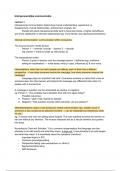College aantekeningen
College aantekeningen & aantal hoofdstukken Interpersonal Communication
- Instelling
- Vrije Universiteit Amsterdam (VU)
In dit document zijn alle college aantekeningen van het vak Interpersonal Communication te vinden. Daarnaast zijn ook 6 hoofdstukken uitgeschreven van het boek Skilled Interpersonal Communication van Hargie.
[Meer zien]






